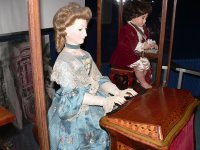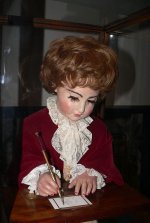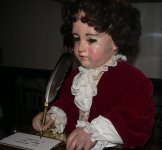There had to be something in the water in the 18th century. A whole lot of people acquired some amazing skills out of, what seems, nowhere. Another one of these brilliant individuals was Pierre Jaquet-Droz. He was born on July 28, 1721, in La Chaux-de-Fonds, in Canton Neuchâtel, Switzerland. He was a watchmaker who lived in Paris, London, and Geneva, where he designed and built animated dolls, or automata, to help his firm sell watches and mechanical birds.

Once again we have a big question mark next to his education. He was supposed to become a clergyman, so he studied theology and philosophy. But from nowhere came affinity for science and mechanics. And as we know, the times, somehow, were very conducive to designing and building some "ahead of its time" mechanisms like the Kulibin's Egg Clock and the Peacock Clock. I personally think the technology was at a totally different level than we are lead to believe. But naturally we are forced to believe that some guys were simply light years ahead of the regular folk those days. The same regular folk, you know, who just a few years earlier were peeing and defecating behind curtains at the Versailles Palace.
Sorry, got sidetracked. So, Jaquet-Droz was introduced to the father and son Jean and Daniel Bernoulli, who were famous mathematicians and physicists. The Bernoullis were into the construction of automatons. Supposedly they influenced Jaquet-Droz’s curiosity about such devices. He was also influenced by Josué Robert, who built clocks and watches the King of Prussia, Frederick William I. Apparently Robert somehow managed to guide Jaquet-Droz without actually training him.
In 1741 he began a seven-year apprenticeship in the field of clockmaking. As the story goes he was very good at his craft. With time he got bored with making clocks and moved on to automatons. He created a few singing-bird mechanisms that could move and sing just like real birds. By 1750 he became one of the leading makers of such mechanisms. The reason I am not going into the complexity of those singing bird mechanisms is because what he made later dwarfs anything you can imagine. His story is pretty interesting. He sold six of his creations to the Spanish Crown and was paid 2,000 gold pistoles. In the process he clearly lucked out with the Spanish Inquision.
Between 1768 and 1774 The Jaquet-Droz automata was created. It consisted of three doll automata built between 1768 and 1774 by Pierre Jaquet-Droz, his son Henri-Louis, and Jean-Frédéric Leschot: the musician, the draughtsman and the writer. The dolls are still functional, and can be seen at the Musée d'Art et d'Histoire of Neuchâtel, in Switzerland.

Two of the drawings that can be made by the draughtsman

With some 6,000 parts, it can be programmed to reproduce any message of up to 40 characters. In the upper half of the Writer’s body is a long vertical cylinder, made up of three sets of 40 cams. One set of cams controls the horizontal movements, another the vertical movements, and a third the amount of pressure the Writer applies to the paper, thus enabling it to make both light and heavy strokes, just like in real human script. Beneath the vertical cylinder, the second part of the mechanism incorporates a disk with 40 spaces on it, so that the order of characters can be selected for the Writer’s message. The automaton can move its head and eyes as it com- poses, and it is able to compensate for changes in distance between the figure and the desk so that the letters remain evenly spaced. Over time the device has been programmed to write different messages, which have included “Les automates Jaquet Droz à Neuchâtel” and, ironically, “I think therefore I am.” - source
Common trait followed: from approximately 1750 to 1800 we have tons of this complicated mechanisms that probably only a few masters of today would be able to recreate. Then everything stops. The skill gets lost. Official explanation is degradingly dull, "As the French Revolution and the Napoleonic era changed the face of Europe, interest in these luxuries ebbed."
KD: Were such items built 250 years ago? Quite possible they were. But they were built by the people who had institutional knowledge of constructing things like this. They had proper tools and adequate education for building items of comparable qualities. They were fairly comparably advanced human civilization which was annihilated a few hundred years ago. In some areas hey might have been even more advanced than ours. I will keep on providing circumstantial evidence of the existence of such a civilization.
Pierre Jaquet-Droz

1721–1790
1721–1790
Sorry, got sidetracked. So, Jaquet-Droz was introduced to the father and son Jean and Daniel Bernoulli, who were famous mathematicians and physicists. The Bernoullis were into the construction of automatons. Supposedly they influenced Jaquet-Droz’s curiosity about such devices. He was also influenced by Josué Robert, who built clocks and watches the King of Prussia, Frederick William I. Apparently Robert somehow managed to guide Jaquet-Droz without actually training him.
In 1741 he began a seven-year apprenticeship in the field of clockmaking. As the story goes he was very good at his craft. With time he got bored with making clocks and moved on to automatons. He created a few singing-bird mechanisms that could move and sing just like real birds. By 1750 he became one of the leading makers of such mechanisms. The reason I am not going into the complexity of those singing bird mechanisms is because what he made later dwarfs anything you can imagine. His story is pretty interesting. He sold six of his creations to the Spanish Crown and was paid 2,000 gold pistoles. In the process he clearly lucked out with the Spanish Inquision.
You can read up on the official version of his life and achievements here.Jaquet-Droz was suspected of sorcery and forced to reveal the automata’s workings to the Grand Inquisitor. Another account claims that the automata were imprisoned briefly while the authorities tried to figure out how they worked. Yet another tale tells of a group of monks who came to see the devices in the Spanish court. When the automata were activated, the monks were overwhelmed with wonder and prostrated themselves in prayer.
Between 1768 and 1774 The Jaquet-Droz automata was created. It consisted of three doll automata built between 1768 and 1774 by Pierre Jaquet-Droz, his son Henri-Louis, and Jean-Frédéric Leschot: the musician, the draughtsman and the writer. The dolls are still functional, and can be seen at the Musée d'Art et d'Histoire of Neuchâtel, in Switzerland.
- The musician is modeled as a female organ player. The music is not recorded or played by a musical box: the doll plays a genuine, custom-built instrument by pressing the keys with her fingers. Movements of her chest show her "breathing", and she follows her fingers with her head and eyes. The automaton also makes some of the movements that a real player would do, such as balancing the torso.
- The draughtsman is modeled as a young child, and is capable of drawing four different images: a portrait of Louis XV, a royal couple (believed to be Marie Antoinette and Louis XVI), a dog with "Mon toutou" ("my doggy") written beside it, and a scene of Cupid driving a chariot pulled by a butterfly. The draughtsman works by using a system of cams that code the movements of the hand in two dimensions, plus one to lift the pencil. The automaton also moves on his chair, and he periodically blows on the pencil to remove dust.
Two of the drawings that can be made by the draughtsman
- The writer is the most complex of the three automata. Using a system similar to the one used for the draughtsman for each letter, he is able to write any custom text up to 40 letters long (the text is rarely changed; one of the latest instances was in honor of president François Mitterrand when he toured the city). The text is coded on a wheel where characters are selected one by one. He uses a goose feather to write, which he inks from time to time, including a shake of the wrist to prevent ink from spilling. His eyes follow the text being written, and his head moves when he takes some ink.
Ladies and Gentlemen!



VIDEO
With some 6,000 parts, it can be programmed to reproduce any message of up to 40 characters. In the upper half of the Writer’s body is a long vertical cylinder, made up of three sets of 40 cams. One set of cams controls the horizontal movements, another the vertical movements, and a third the amount of pressure the Writer applies to the paper, thus enabling it to make both light and heavy strokes, just like in real human script. Beneath the vertical cylinder, the second part of the mechanism incorporates a disk with 40 spaces on it, so that the order of characters can be selected for the Writer’s message. The automaton can move its head and eyes as it com- poses, and it is able to compensate for changes in distance between the figure and the desk so that the letters remain evenly spaced. Over time the device has been programmed to write different messages, which have included “Les automates Jaquet Droz à Neuchâtel” and, ironically, “I think therefore I am.” - source
Common trait followed: from approximately 1750 to 1800 we have tons of this complicated mechanisms that probably only a few masters of today would be able to recreate. Then everything stops. The skill gets lost. Official explanation is degradingly dull, "As the French Revolution and the Napoleonic era changed the face of Europe, interest in these luxuries ebbed."
KD: Were such items built 250 years ago? Quite possible they were. But they were built by the people who had institutional knowledge of constructing things like this. They had proper tools and adequate education for building items of comparable qualities. They were fairly comparably advanced human civilization which was annihilated a few hundred years ago. In some areas hey might have been even more advanced than ours. I will keep on providing circumstantial evidence of the existence of such a civilization.
- Did Jaquet-Droz build these dolls? If he did, he belonged to that civilization. Or may be his assignment in history is to be the creator of these beautiful masterpieces.




